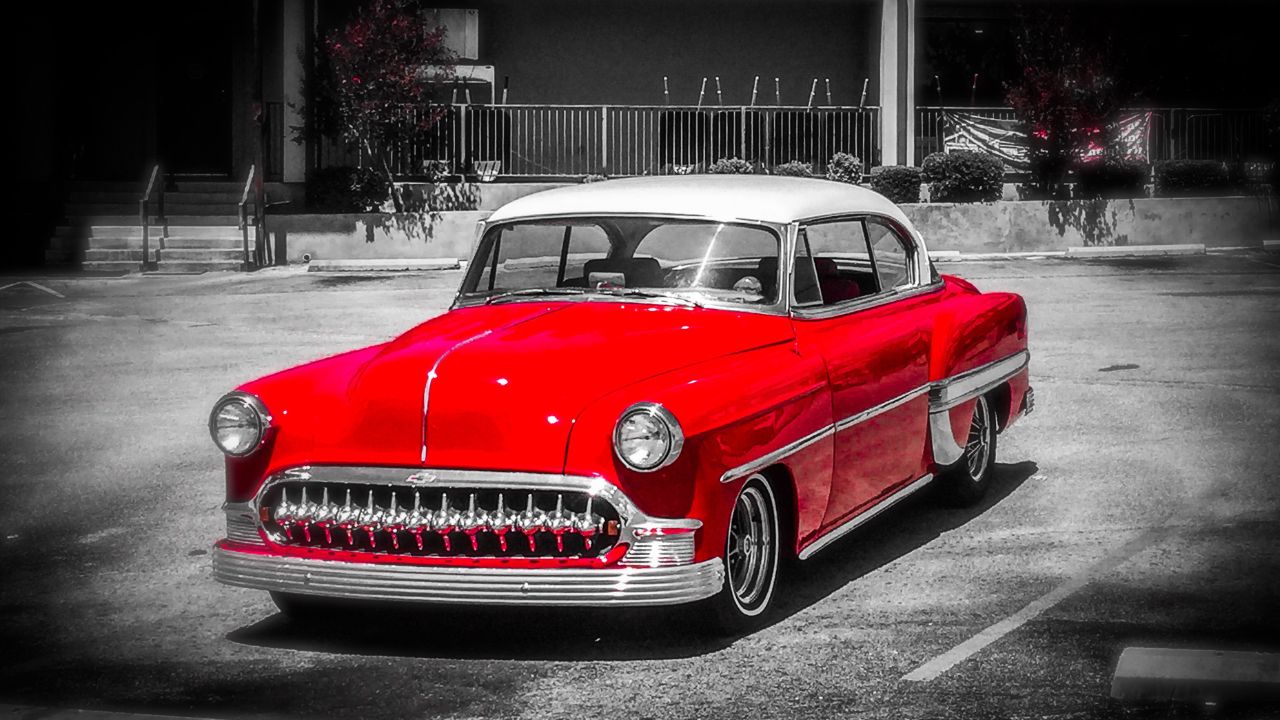
Are you a huge fan of muscle cars. There are lots of pictures of muscle cars on the internet. Pinterest, Facebook, Tumblr or Twitter are all good places to start. You may find your favorites that you like, which are great for saving to your computer. It's important to have fun with your images of muscle cars if you really want them to stand out.
'64 Pontiac GTO
The first production model of the Pontiac GTO was released in 1964, kicking off a new trend in muscle cars: the midsize size. With 32,450 orders placed for the 1964 Pontiac GTO, it was one of the most popular cars of that year. The GTO was made a separate model in 1966 and sold well. The exterior was unchanged, but there were noticeable changes underneath. The V8's 389ci displacement was increased to 400 cubic inches. The fastest single-carb version was rated at 360 horsepower. In addition, the old two-speed automatic transmission was replaced by a three-speed TH400 transmission.
Pontiac introduced GTO the following year. It started a race for muscle cars that would last until the early 1970s when fuel economy was more important. Insurance companies didn't approve of high-powered cars. But street-fighting opponents might have caught up with GTO's speed.

'63 Corvette
This is the place to go if you are looking for a classic 63 Corvette. Here you'll find photos of the earliest generation of the American muscle car. These pictures are taken in California, where it was manufactured. While it isn't possible to find an exact reproduction, these images are representative of the era. Since its introduction in 1963, the '63 Corvette has been a popular car around the globe.
The 1963 Chevrolet Corvette was the first sports car of its generation. It was considered to be the most distinctive American sports car of the early 1960s, and featured a split rear window. Many owners, however, later bought kits to replace the split rear window, and today, these vehicles are quite rare. The split-window was a design that remained popular, but was soon rejected by GM executives. The split window made it difficult to see behind the car, which was a costly error.
'64 Firebird Trans Am
If you have never had the chance to see one of the original Firebird Trans Ams, now is your chance to get a firsthand look. These vintage cars were first released in 1982, as a 1983 version. They shared many of their mechanical components with a Chevrolet Camaro. The Trans Am was also immortalized by Kitt, the Night Rider star. The Trans Am, in addition to being well-known, was also the first American car with dual airbags, short/long arms front suspension, and nonrusting composite body panels.
The original Firebird was introduced by the company in 1967. It continued to be produced until 1969. The first Firebird generation lasted eight years. The car's second-generation lasted from 1998 to 2001 and has been a collector's piece for decades. The Pontiac website has photos of 1964 Firebird Trans Ams. You can also view them on other car enthusiasts forums. You can see them all here. Take a look at the gallery below to see more of the car.

'65 Chevelle
The Chevrolet Chevelle is one of the most popular muscle cars of late 60s. The mid-sized performance car was a big seller and was among the top-selling of its day. It is still a highly sought-after muscle car and collectors as well as hot rodders are vying for it. The "muscle car", as the Chevelle images of muscle cars from '65 Chevelle clearly illustrate, is the ideal example of what that term means.
The Chevrolet's answer the Pontiac GTO, Ford Mustang, and the 1965 Chevelle. The Chevelle's high price tag was offset by the fact that it was produced in just 201 examples. It's not in great condition however. The car was completely untrimmed and had primer covering nearly every body panel. Someone tried to attach a Mopar scoop to the hood.
FAQ
How do I fix my vehicle as a hobby?
If you are interested in cars, why not take it on as a hobby? You can learn to fix them, buy them parts, and even sell them. It would make a great pastime if you're looking for something different to do.
But it is not easy to turn this into your full-time occupation. It takes dedication and hardwork. It will also require a large amount of investment.
If you don't have any good reasons to be involved in cars, it may be better to just let it go.
What is the difference?
The two are similar but not identical. Both a mechanic and an automotive technician can repair cars.
A mechanic must have good manual dexterity and be able to perform simple tasks quickly. They must also be able to diagnose problems accurately and repair them effectively.
An automotive technician must be more technically proficient than a mechanic. They need to be able use tools such drills and wrenches, and read blueprints.
They must also be able perform complex procedures safely. They need to be familiar with various types of engines and electrical system.
They must also understand the interplay of different parts.
As a result, mechanics typically make less than technicians. But there are many opportunities for both jobs.
Is it important which college I go?
It's not true. There's no difference between colleges regarding getting into the automotive industry. Some schools have better programs than others, so you might want to look elsewhere if your goal is something more specialized.
Is a career in automotive mechanic promising?
The automotive industry is full of exciting opportunities for those who are dedicated to excellence. This field requires hard work and the willingness to learn from others.
Communication skills are important as customers and coworkers will often be your main focus. You should also be willing to travel and work long hours, making commuting difficult.
You can take classes at universities and community colleges if you are interested in a career as an automotive technician. Many schools offer programs for students who are interested to learn about auto sales, customer service, or repair.
If you decide to pursue a degree, you should study mechanical engineering. It is possible to earn a bachelor’s degree in only four years.
Many companies will hire students straight out of college. Therefore, it is a good idea to look for employment while still pursuing part-time studies.
After you've finished your education, it's likely that you'll need to go through some training before you can be hired as an auto technician.
This means that you must pass the Automotive Service Excellence exam. This test covers topics such engine maintenance as brakes, steering, suspension, etc.
After passing the ASE exam, you can apply for a National Institute for Automotive Service Excellence license.
Private individuals can have their vehicles repaired with a license. You'll be paid based upon the number of services provided.
It's important to note that not all states require licensing. However, if you plan to work outside your home state, you'll need to obtain a license.
Some states won't issue licenses until you have completed a certain amount training. If this applies to you, then you may need to find another option.
Is it difficult to find a job as a mechanic in the automotive industry?
Yes, it's possible. Garages often advertise their jobs online and people just apply because it seems fun. Try applying to a few jobs and seeing if the garages accept student applications. Another option is to ask family members and friends if anyone works in this industry. You might be able to refer someone.
Is it worthwhile to become a mechanic?
The answer depends on what you are looking for in life. If money is your goal, then you can answer "yes". But if you are searching for meaning and purpose, then you should not answer this question.
If you don't have any mechanics skills, then there's no point getting into it because you'll just end up wasting time. It's not going to make you rich. You won't become famous. It is unlikely that your life will change.
You'd have to spend years learning how things work. You would still need to hire someone to fix your car if it breaks down. That's why most people don't bother doing it at all. They find something else to do.
You can make a lot of money if you are looking to do well. But if you want to live a meaningful life, stay away from the mechanic's industry.
Statistics
- The U.S. Bureau of Labor Statistics (BLS) reports that the job outlook for automotive service technicians and mechanics is expected to decline by 4% from 2019 to 2029. (indeed.com)
- According to the BLS, total auto technician employment is expected to exceed 705,000 by 2030. (uti.edu)
- According to the BLS, the median annual salary for automotive service technicians and mechanics in the United States was $44,050 in May 2020. (uti.edu)
External Links
How To
How to properly diagnose your vehicle for repair
To determine if your car needs repairs, you should first look at the symptoms that your car presents. You can then follow these steps for a proper diagnosis of your vehicle.
-
Check engine lights. Inspect the dashboard light indicators. These include the engine lights, the oil pressure gauge and the battery light indicators. The RPM gauge and coolant temperature gauge should also be checked. It could indicate that your vehicle is having problems.
-
Pay attention to the treads on your tires. If the tires are worn out, they could cause problems with handling and braking. It is also important to inspect the wheel treads. You should ensure that they are clean and smooth. This can be done by removing the wheels from the vehicle and taking them off. You can check the tread wear with a flashlight.
-
Monitor the level and consistency of your brake fluid. Keep track of the brake fluid level in your vehicle. This will ensure your brakes function properly. Your brakes may fail if the brake fluid level drops.
-
Make sure to test the suspension system. Vehicles usually have a suspension system that helps absorb shocks and vibrations while driving. It allows for better control, smooth acceleration, and deceleration. If your vehicle has a suspension problem, it might feel wobbly or shake uncontrollably. To test whether your vehicle has a suspension issue, try putting weight on the front or rear axle and observe the movement.
-
Examine your steering column. Steering columns connect the steering wheels to other parts of the vehicle. The steering column can often be damaged by an accident. It is recommended to replace any steering column that feels loose, or shakey.
-
Observe the exhaust pipes. The exhaust pipes transport gases from the combustion chamber to outside. You can let harmful fumes into your home if your exhaust pipes crack or leak. Also, if your tailpipe is bent, you should fix it immediately.
-
Take a look under your hood. If you see anything unusual, take a look under the hood. There could be fluid leaking from your engine. A professional technician should be contacted if your engine compartment emits an unusual smell.
-
Make sure to check the air filter. The air filter in your vehicle collects dirt and dust from the environment. A dirty air filter causes your vehicle to run poorly. Replace your air filter regularly.
-
Verify the fan belt. Your vehicle's fanbel connects the engine and transmission. If the fan belt fails, the engine won't start. The process of replacing the belt is straightforward. All you need are a screwdriver & pliers.
-
Check the radiator hose and hoses. The radiator hose carries water from the radiator to the engine. It can cause hot liquid to leak onto the engine if it is damaged or cracked. The hose can be repaired with a pair or needle-nosepliers, and a wire brush.
-
The windshield wipers should be checked. Windshield wipers work by using electricity to remove rain and snow. If they stop working, streaks could be left on your glass. Simply change the washer oil to fix the problem.
-
The battery cables should be checked. The batteries provide power to the electrical systems within your car. If you are replacing batteries, disconnect the negative cord first. Failure to do so can damage your alternator.
-
You should check the headlights. The headlights will illuminate the road ahead. Poor visibility can result if the headlights don't function properly. To determine if your bulbs are out of date, check them.
-
Pay attention to the lights. If you approach other drivers at night, lights will warn them. You could be distracted and cause an accident if one does not work.
-
Make sure you check your brakes. Before you have a collision, brakes slow down your car. If the brakes fail to work correctly, your car could lose control and collide with another vehicle.
-
Change the oil. The oilkeeps your engine lubricated. It protects metal parts and prevents them from wearing too quickly. It is recommended that the oil be changed every other month.